Why Should You Transplant Strawberry Plants?
Most strawberry plants will produce many runners over the course of its life. For the home gardener, this is great! You get to buy (or otherwise obtain) a few strawberry plants and watch them multiply themselves exponentially. However, the little fellas don’t know when to stop producing runners when the maximum productive capacity of a confined strawberry bed is reached.
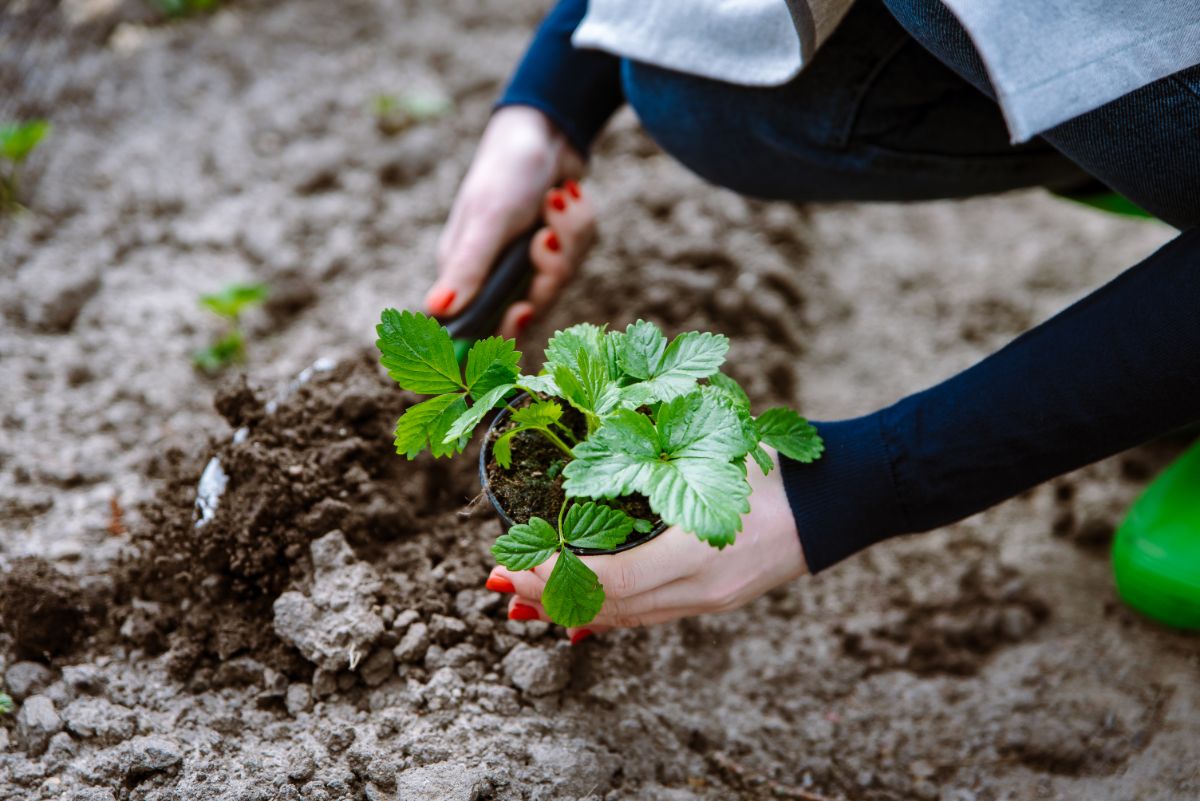
So, a gardener who desires lots of high-quality strawberries will have to remedy this overcrowding. It can be done either by thinning the plants or transplanting the plants to a new area. Also, if the soil isn’t particularly well-suited for growing strawberries, transplanting strawberry plants to a rich, sandy loam with good drainage can make all the difference in the world.
Transplanting the unneeded strawberry plants to new beds can also help develop new strawberry patches and initiate a strawberry bed rotation system that maximizes strawberry production. Additionally, thinning an existing bed by removing and transplanting strawberry plants elsewhere increases airflow which can help reduce many of the fungal diseases (see the Strawberry Plant page for more details).
Jump to:
Transplanting Strawberry Runners
In general, the established plants are going to produce the most and biggest strawberries. It takes some time for a strawberry plant to root well and produce maximally, so a gardener should count on year 2 and year 3 being the years where a strawberry plant is most productive. Some strawberry plants will still produce exceptionally well in year 4, but most will start to lose a bit of their youthful vitality after year 3.
To leave the roots of the most established strawberry plants intact (so that they will continue to produce strawberries at their highest possible level), it is usually best to transplant strawberry runners that were sent off and rooted that year. To make transplanting strawberry runners easier, see the post on Strawberry Plant Propagation. Whether you let the strawberry runners establish at will or guide them so that they establish into moveable pots or containers, the next section will deal with what to do next.
When Is the Best Time to Transplant Strawberry Plants?
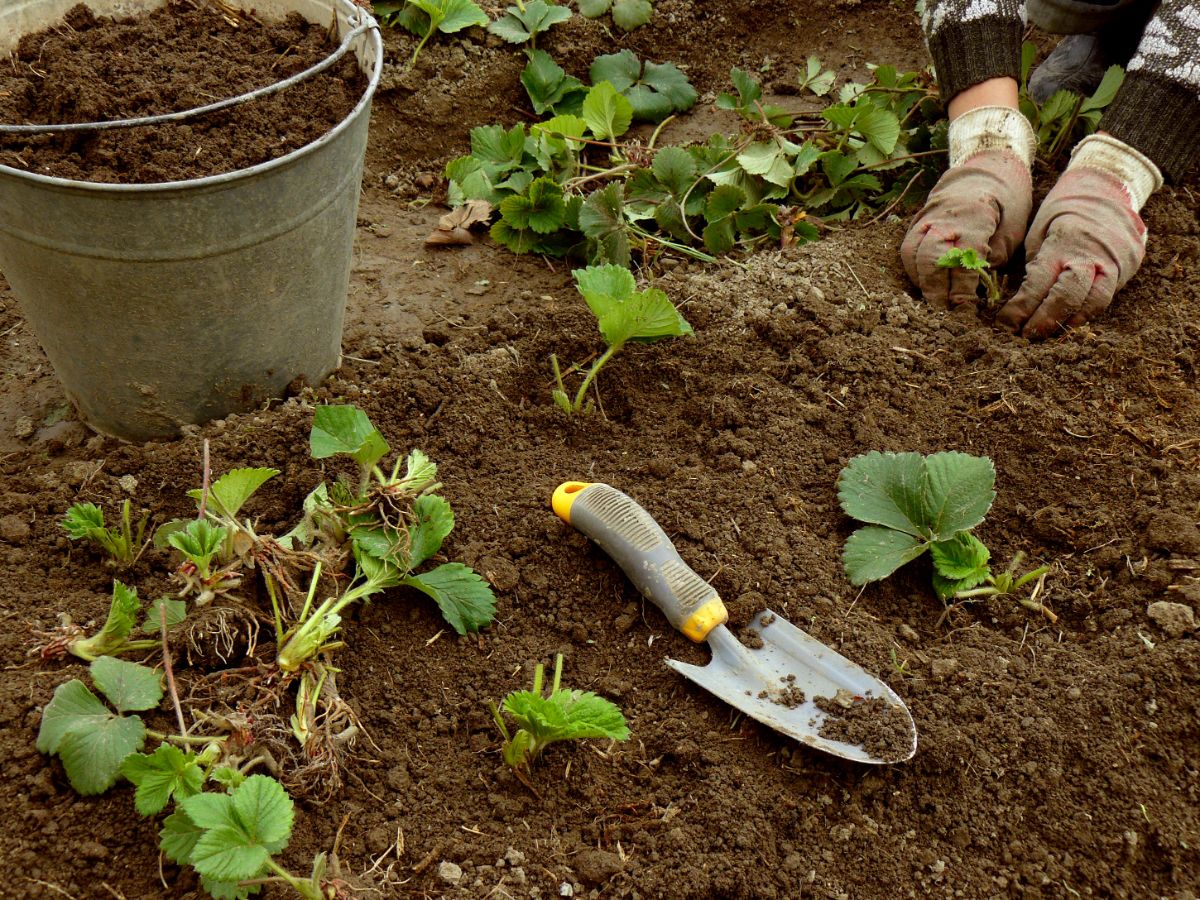
So, when should you transplant strawberry plants? If you purchase strawberry plants on the internet (see our directory of companies who offer Strawberry Plants for Sale Online or Buy Strawberry Plants by variety if you know which ones you want), you will likely be mailed the plants in the spring according to the recommended planting time for your hardiness zone. If you get them in the spring, put them in the ground as soon as possible.
As it takes a while for the plants to establish themselves, foregoing the smaller crop during the subsequent growing season after planting will provide much larger harvests in the following years (see the Growing Strawberries page for more details on removing flowers and runners).
If you already have an established bed, you should generally transplant strawberry runners that have already established themselves. Carefully digging up the younger plants should be done in the fall. Typically, late August is the best time to transplant for most of the zones in the United States. However, in the warmer zones of the south, transplanting can be done later. In the much cooler climates, transplanting strawberry runner plants can be done earlier.
By transplanting strawberry runner plants at this time (in late August), the yields obtained during the following growing season will be maximized. Remember, however, that strawberry plant transplants can grow successfully at just about any time during the growing season as long as they are well-watered and have a hospitable growing location, but transplanting them during the hot summer months takes its toll on the plant.
How to Transplant Strawberry Plants
It is important to know how to transplant strawberry plants correctly so that they aren’t unnecessarily damaged and the stress to the transplant plants is minimized.
To transplant:
- Prepare your new location first. Make sure it is hospitable, sunny, rich, sandy loam, well-drained with slightly acidic soil, generally well-suited for strawberry plants, and historically acceptable (see the Growing Strawberries page linked above for more on the best growing conditions and soil-history concerns).
- Select the strawberry plants you will be transplanting. Generally, it is best to transplant established, young runner plants that are only a few months old. Choose only strawberry plants that look healthy, and remove any flower buds, damaged or discolored leaves, and runners prior to transplanting.
- Obtain a substance or material that will hold moisture. Sphagnum or peat moss is probably best, but something as simple as wet paper towels is usually sufficient. It is very important to keep the roots of your transplant strawberries moist during the transplanting process.
- Dig up your selected and prepared runner plants (or other strawberry plants). Take care to remove as much of the strawberry plant’s roots as possible from the ground (so that most of the roots are attached to the plant). Once free of the ground, cover or wrap the roots with your moistened peat moss (or other selected moistener).
- Transplant strawberries to your new, prepared strawberry bed. Do not dig up all the selected strawberry plants at one time and then try to plant them all at one time. Transplant one strawberry plant at a time. After each plant is in the ground at its new location, water it thoroughly before transplanting the next selected strawberry plant. This minimizes stress and increases the probability of success. Waiting until all the plants are transplanted before watering all the transplants simultaneously with a sprinkler or other apparatus may cause unnecessary plant loss.
Transplanting Strawberries: Systems
To maintain the vigor and production of your strawberry plants, you may want to utilize a strawberry transplanting system. By transplanting strawberry plants to new strawberry beds each year, you can maintain three (or more) vigorous, well-producing beds. The steps below can be modified to allow the strawberry plants to fruit for additional years or fewer years as desired. By not transplanting each year, you can maintain the cycle with fewer strawberry beds.
Year 1: Transplant Strawberry Plants from Established Bed
If you ordered strawberry plants online or bought them from a local nursery and planted them in the spring, the strawberry bed likely won’t be established and into “Fruiting Year 1” until the following spring. At the end of the first fruiting year (the first year of the strawberry transplanting cycle), transplant several of the healthy, well-established strawberry runner plants to a new bed (bed 2) in the fall. Take care of your beds and winterize them as described on the Growing Strawberries page (link above).
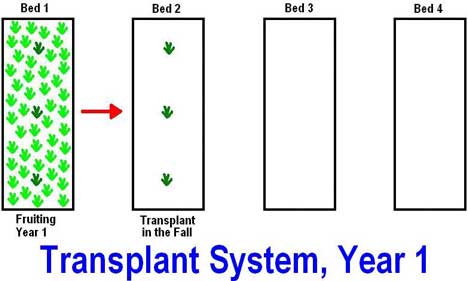
Year 2: Two Fruiting Strawberry Beds, Another Fall Transplant
In year two of the system, the transplant strawberries in bed 2 will produce runners during their first fruiting year. The strawberry plants in bed 1should produce a good crop as the strawberry plants will be in their second fruiting year. You may need to thin the runner strawberry plants in bed 1 if they become too thick. In the fall, transplant strawberry runner plants from bed 2 to a new bed (bed 3). Overwinter all beds again.
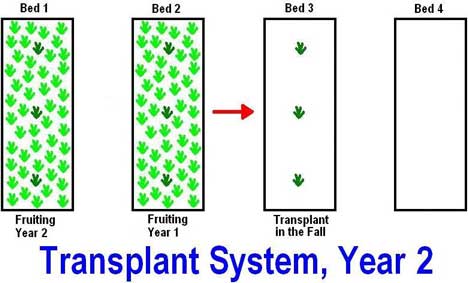
Year 3: Three Producing Beds, Another Transplanting Strawberries Session
Bed 1 is now in its third production year. It is likely that these old plants will begin losing their productive capability soon. Beds 2 and 3 should also provide ample harvests. In the fall, transplanting strawberries occurs again. Following the same pattern, runner plants from bed 3 are transplanted into bed 4 in the fall. Also in the fall of year 3 after the strawberry plants in bed 1 have completely finished producing strawberries, they should all be removed. After removing, the renewal process should begin and continue into year 4.
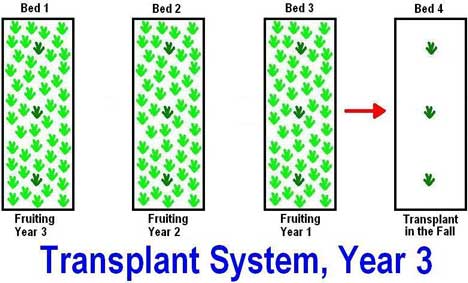
Year 4: Renew the Bed Before Transplanting Strawberry Plants Again
The strawberry plants in bed 1 should have been removed after they were completely done producing fruit in year 3. As soon as that occurred, bed renewal should begin. Rich organic compost, aged manure, or other soil enhancers should be generously added and tilled in. Either organic or non-organic fertilizers can be added as well. Add rich organic matter 2-3 more times over the course of the spring and summer months of year 4. In year 4, beds 2, 3, and 4 will produce a harvest while bed 1 is being renewed. In the fall of year 4, transplant healthy runner plants from bed 4 back to bed 1.
As long as your plants remain disease-free, this system should provide ample harvests from three beds from strawberry plants in their prime production years. By replanting in the same beds, you do have an increased risk of your strawberry plants succumbing to one of the various strawberry plant diseases (reference the Strawberry Plant page at the link above for more details).
Once the transplant runner plants are in bed 1 again, the cycle restarts. Barring disease and assuming sufficient nutrients are re-introduced and combined with the soil to properly nourish growing strawberry plants, this system should theoretically sustain a 3-bed berry harvest indefinitely. The size of the beds are limited only by the gardener’s ability to maintain them!
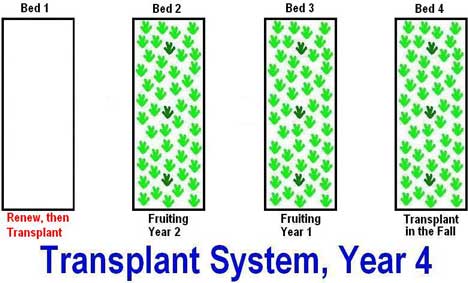
Transplanting Strawberry Plants: Conclusion
Hopefully this guide to strawberry plant transplanting has helped you. You should now know why you should transplant strawberry plants, when you should transplant strawberry plants, how you should transplant strawberry plants, and that it is usually best to transplant strawberry runner plants that are young and healthy. If you need extra help remembering which plants are old and which are runners within a bed, you can always use the cheap white plastic label stakes or Popsicle sticks to mark individual strawberry plants.
Hopefully, the strawberry transplanting system described will help accomplish your strawberry-producing goals as well. Good luck, and happy transplanting!


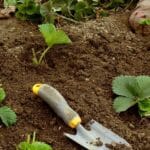







Leave a Reply